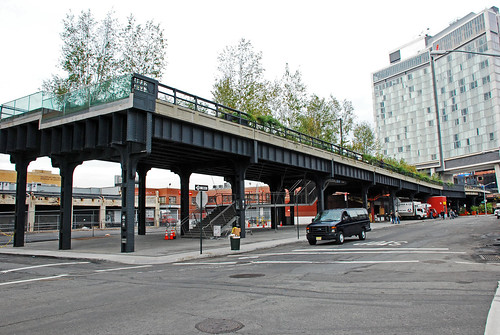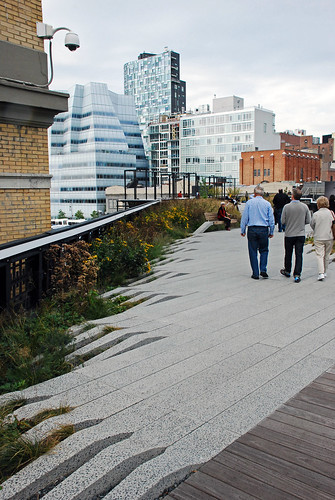For what it’s worth, I think the High Line is fabulous¹. The architectural details are thoughtful and well-designed, the landscaping is superb, and the view of the city is at once refreshing and reässuring; the perspective is new but the city is the New York we know and love. While some of the ambition of the original design has been compromised (no wetlands suspended over 14th St? Will we still get that awesome tree lift?), it’s still a very impressive place. Even the fact that it’s there at all is exciting, and I can’t help but wonder how many other potential gems are hidden in the city, waiting to be found. (Los Angeles, capital city of underutilization and missed opportunity, has taught me all about this.)
In the new urban chemistry of New York, the High Line is both a byproduct and catalyst of gentrification. This is clear both in the glitter of the starchitecture developments springing up around it and the people who come here. Yet walking amid the hipsters and tourists, I was surprised by the pacing of the whole experience. It's impossible to hurry here, not that you'd want to. Field Operations artfully segmented the path into landscaped episodes–grasslands, woodlands, open spaces, and more intimate ones–and the result is a true urban oasis. This is reflected in the way people use the space: they sit and read, eat their lunches, crowd-watch. Many were, like me, taking snapshots with their digital SLRs; others leaned over the railings and gazed at the city below. Most of all, people simply stroll (and in lower Manhattan, this is a sight to behold).
Much of this, I suppose, has to do with scale. The vast acreage of Central Park allows for programming like baseball fields, ice-skating rinks, and amphitheaters. The wider, eastern half of the Promenade Plantée–the only real precedent for the High Line, running along an old rail route through the 12th in Paris–is crowded with local joggers and cyclists; here there is really only room for strolling. You go to there just to be there, not to go anywhere or do anything besides escape the sidewalk. Unlike Central Park, on the High Line everyone’s a tourist. After all, it doesn’t go anywhere anymore. It’s just there, a narrow park floating over Chelsea. Ostensibly it connects, or will someday connect, the Meatpacking District with Hudson Yards, but no one actually walking between those two places would use its meandering path for expedience. As a landscape, it is not a means but and end to itself. As a public space, the High Line is social rather than instrumental.²
The creation of public space from the ruins of vestigial infrastructure is, in a way, the inverse of the Sylmar project, which is about using new infrastructure as an opportunity to create public space. I’m not looking to repurpose anything, or to change one thing into another, but, by coupling public transportation and public space, actuate them both. Their relationship should be one of mutual enablement. On one hand, connecting the rail station to the city with public space will embed the station into the fabric of the city–an essential part of making mass transit work for American suburbia. On the other hand, attaching real function to the space transforms it–as a place, is not passive but active, neither a park (social) nor a plaza (civic) but an instrumental space. The reciprocity of these two aspects is vital to the project: the more people ride the train, the more lively the space; the more lively the space, the more people are drawn to the train. And with ridership projections at 16,000 passengers a day, Sylmar may be the busiest station between Los Angeles and San Francisco, so the numbers are there. The key will be in how the link is designed–my job in the spring.
PS The pedestrianization of Times Square is awesome, even if the place is still full of European and Midwestern tourists. I didn’t know, though, that the thing at the very apex of the intersection was an Olive Garden.
[1] For other notes around the High Line, see this, this, and this, as well as JHK's predictable bitchfest here.
[2] see Elizabeth Blackmar, "Appropriating the Commons: The Tragedy of Property Rights Discourse" for transportation facilities and the public realm.



Very insightful and refreshing post, Mr. Dunham. I look forward to seeing how you continue to develop your ideas on the function of the transit space to what you describe as "instrumental". Would this involve personalization or commercialization of the space (perhaps both?) Because how one begins to address the public attitudes towards this space seems just as (if not more) critical than what's to be done to it, so you're definitely on the right track there. Track. There's a pun. Ha.
ReplyDelete